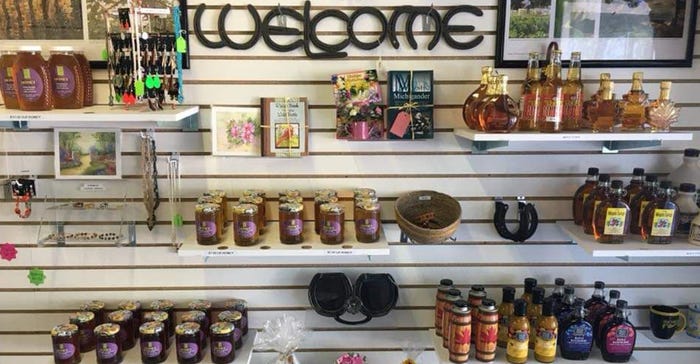November 5, 2018

Upper Peninsula beekeeper Dane Wallis is trying an experiment this winter to save his bees from certain death. Wallis owns D and S Beekeepers in Sault Sainte Marie. In just a few years, his profitable business has turned into an expensive hobby because of the bee-killing varroa mite.
With the mite’s arrival, overwintering losses have gone from a manageable 10% to 100%.
“Varroa is extremely critical,” he says. “No livestock farmer has to do what beekeepers have to do,” the 20-year beekeeper says. “Any farmer, sheep, cattle, chicken, who every year had to replace the entire stock, wouldn’t survive.”
This year Wallis set up a winter experiment to get his varroa numbers to a level he believes the bees can survive.
“I am putting some indoors in a controlled environment,” he says. “I am putting some out traditionally. One of the yards has an open south-facing wall. I am going to wrap the bees in the traditional tar paper, give them southern exposure and box them in with Styrofoam. I am going to have some out in the field, and I am going to have some that are half in and protected.”
He gave all the bees the same varroa treatment.
“It’s a major experiment,” he says. “If miraculously I come through with 50% [of bees left], I will be doing cartwheels.”
Two years ago, Wallis tried keeping his hives in indoor storage for the winter with temperature and humidity controls.
It was an expensive operation, he says. “They went in around Thanksgiving. It’s a long time for them to sit from Thanksgiving until April.”
Wallis says the bees were doing great at the beginning. However, slowly, like dominoes, they fell to nothing. “It was very frustrating,” he says. “It was purely varroa, not a glitch in the system. Everything was monitored, and I kept records.”
He recounted his efforts to the local Superiorland Beekeeping Association.
“I told them I don’t know it all by any means, but if you don’t have the varroa under control, I don’t care what you do for winter preparation. No matter what you do, they’re dead. You might as well call them ‘gunnadie’ bees. I t’s inevitable, they’re going to die.”
With 100% losses, restocking is expensive. Wallis pays $130 to $200 a package to stock his 70 hives,
Splitting is not necessarily a viable option. “Very seldom up here, unless you have a very robust queen and a strong colony,” Wallis says. “We don’t have the time,” he says. “The season is from April to August, and then you better start putting the feed on them for the winter.”
Good environment
For the bees of the Upper Peninsula, summer is golden,
“The nectar flow comes on like gangbusters,” Wallis says. “We get a little bit of a dearth, for maybe at the most two weeks, and then it is on again.”
“Diversity is huge for the bees and we have that,” he adds. “We have wild flowers, and we don’t have big monoculture farms so they’re not using the sprays and the pesticides.”
The bees are getting what they need. “We have abundances of everything up here, but time. You can randomly drive any direction; it doesn’t matter. Set a beehive, and you’re in business. It is that abundant here,” Wallis says. “It’s perfect except for the weather, and even the weather is tolerable. Bees are very resilient, but they’re not resilient enough to fight off that varroa mite.”
“I have had bees that look great,” he says. “They look sharp, viable and hardy. Then, where did they go? It’s the fall, and they disappear. The vanishing bee. I’m thinking this is CCD. It’s not the cost; it’s the problem. Why are they going?”
Adopt-a-hive program
“Last summer, Wallis brought something new to UP beekeeping by setting up an adopt-a-hive program.
He discovered the program was popular in Europe. So Willis decided to give it a try. He built a website and talked to people who visited his muffler shop. A charge of $300 covers the bees, the equipment and his time.
“I supply everything,” Wallis says. “All they need is a backyard. We check to make sure the bees are not a nuisance to neighbors.”
He has protective suits for adults and children. After a couple of weeks, he returns and shows the new beekeepers how the hive is working.
“Honey is harvested up here once in the fall,” Wallis says. “I can average 100 pounds of honey a hive. I give them 10 pounds of raw honey bottled. “They typically want more, until they see a case of honey and realize 10 pounds is a lot of honey.”
Last summer 13 people took up the adopt-a-hive offer, which he considers a great response. About 50% have already said they want him back next year.
Willis is considering increasing the number of hives he’ll make available for the program next summer.
“I know I could because the interest is there, but I want to do it properly,” he says. “I want the people to have a good experience.”
This past year, Wallis began selling 3-pound packages of a queen and bees he gets from wholesale suppliers in Georgia to other beekeepers.
Wallis has been commercially breeding queens for about three years. He sells his product locally and is considering branding it as Upper Peninsula honey.
“Our honey is something different,” he says, “I don’t know if it is because we are so much closer to nature or so much wilder,” he says.
Wallis’s location in Sault Sainte Marie is 345 miles north of Detroit and 470 miles northeast of Chicago, making him one of the most Northern beekeepers in the eastern United States.
“We’ve got everything going against us, and we still do it,” he says. “Beekeepers are weird; we have to do it.”
Harman writes from Brighton, Mich.
About the Author(s)
You May Also Like




